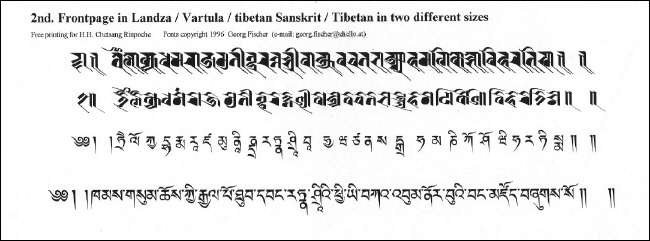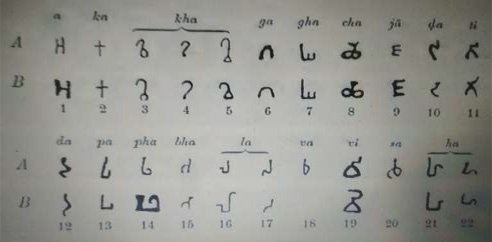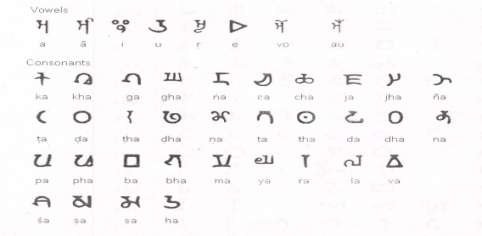Tibet (Myth, Religion and History)
by Tsewang Gyalpo Arya | 2019 | 70,035 words
This essay studies the history, religion and mythology of Tibet, and explores ancient traditions and culture dating back to more than 1000 BC. This research study is based on authoritative texts and commentaries of both Bon (Tibet's indigenous religion) and Buddhist masters available in a variety of sources. It further contains a comparative study ...
7. The Scripts; dBu can and dBu med
The general belief is that the Tibetan dBu can script was derived from Lantsa [Tib:Lan tshva, Lan nya tshva] and dBu med script from Wartu [Tib:Wa rtu]. Nyangral said that there were sixty four scripts in India around that time and these scripts could be summarized under three: Lantsa, the letter of god, Nagara, the letter of Nagas, and Bhadruma, the letter of human. He said dBucan was based on Nagara and dBu med on Bhadruma. Kachem Kakholma says the teacher Li byin ti ka knew twenty scripts and showed these scripts on a pillar to Thonmi and asked him which of those he wanted to study. The pillar was said to be near some sea. If we could locate this pillar it would be of great benefit in throwing more light in this study of scripts.
Georg Fischer, in his website on Lantsha, Wartu and other Indian scripts in Tibet, has valuable information on different scripts including Zhangzhung smar-yig. Lantsha was actually Nepalese Ranjana script which was modified by Tibetan masters in 11th century and widely used in Tibetan religious scriptures.
Let us see what the Lantsha and Wartu scripts look like[1] :

Tshe tan zhabs drung has made following observation in Thon mi'i zhal lung:
In Sila Badhra's Chos 'byung [1371 CE], from Nagara, Tibetan script gZab mar came; from Bah-tu-ri came bShur-mar script. In Bu-ston Chos-'byun [1322], it was copied from Ka-che script. In dPa'-bo tsug-lag phreng-wai Chos-'byung [1564], it was based on Nagara and Kache script. Fifth Dalai Lama said from La-nya-dza came dBu-can and from Wa-rtu came gShar-ma. Thuken chokyi Nyima [1801] writes that From Na'-ga-ra came the mGo-can gZab and from Wa-rtu came the mGo-med gShar.[2]
dGe-'dun chos-phel has in his book, White Annals[3], said that scholars like Bu-ston had attributed Tibetan script to Nagara, others contended Lantsa and Wartu as source of Tibetan dBu can and dBu med scripts. Bon scholars assert that there was a vast teaching of Bon before Srongtsan Gampo and that it was not true to say that there was no writing system in Tibet. They pointed sTag gzig spungs yig as the source of Zhangzhung Yig rgan, and then to sMar brag, which gradually changed to bBu can and 'Bru mar.
A copy of an article written by dGe 'dun chos 'phel in Tharchin Babu's Tibetan Newspaper in Kalimpong [Jan, 1918], which Professor H. P.Gangnegi of Delhi University shared with me, dGe 'dun chos 'phel has clearly refuted the theory that dBu can and dBu med came from Lantsa and Wartu.
Early historians like 'Gos lo tsa ba etc. had not made any reference as such. Bu ston said it was copied or based on Kache-scripts, and did not say that dBu can and dBu med were invented from the beginning. Saying that it was based on Lantsa [lan nya dza][4] is not true, because Lantsa scripts came in a later time. During the time of Buddha, Maurayan and Gupta dynasty, different scripts of Magadha came, and these scripts were used on the pillars the respective Kings had erected. Therefore, the script from which Thonmi derived the Tibetan script has to be the script of the time of Lobpon Nagmo Khol, King bZhon nu sbas pa, King Nyima'i go cha etc.. It is because writings on the pillars and copper plates of those times which the Indian Pandita could not read, a Tibetan who has no idea of Indian scripts could read it fairly….[5] dGe 'dun chos 'phel concluded that he thinks that origin of the Tibetan writing was Gupta scripts. He has produced a specimen copy of the writings on the plate in the book[6], but the copy produced in the book was in print form, so the veracity is doubtful. We need to see the original or copy of the original. If we study the Gupta script from a distance, it does looks like Tibetan writings as said by dGe 'dun Chos 'phel, but a closer observation does not support what the scholar has said.
According to Rigpa Shedra:
Lantsha (Wyl. lanya-dza) is a Tibetan script developed for writing the Sanskrit language. It was developed around the 11th century from the Nepalese Ranjana script, and retains many similarities. It is most often used for writing the Sanskrit titles of translated texts that have been brought to Tibet from India. It was also commonly used for writing Sanskrit mantras well as seed syllables, Tibetan practitioners were encouraged to visualize them in this script[7].
Thus it is very clear that Lantsa and Wartu were not the origin of Tibetan dBu can and dBu med. dGe 'dun Chos 'phel suggests we need to look at the Gupta scripts, which were popular during the period of King Harshavardana of India and Amsuvarman of Nepal. Gupta script is said to be one of the many variant scripts of Brahmi lipi, but early Brahmi script has no resemblance to the Tibetan script.
Brahmi script of around third BCE has little resemblance, especially cha, ja, pa and pha look similar to the Tibetan counterpart. Sample of Brahmi Gupta script as follow:
[George Buhler, Origin of Indian Brahma][8].

Gupta Scripts were said to be descended from Brahmi scripts. Among the Gupta scripts, nearest to the Tibetan script is Silabaro Gupta Script. Below is the sample:[9]

Here we can see how the ancient Brahmi script has evolved. Now we find more similar scripts, i.e. ca, cha, ja, na, pa, pha, ba and la. But we cannot conclude Gupta script as the origin of Tibetan script just because of the similarity in the shape of some six syllables in the two scripts. It is probable that Zhangzhung script influenced the evolution of Brahmi scripts. Let us now look at the grammatical aspect of the Tibetan language.
Footnotes and references:
[1]:
http://www.lantsha-vartu.org/printable/lantshascript/index.html
[2]:
Tse tan zhabs drung, Thon mi'i zhal lung, p-24-25
[3]:
dGe-'dun chos-'phel, rGyal-rabs deb-ther dkar-po, p-90
[4]:
The author used this spelling "La nya dza" for Lantsa
[5]:
Appedix-1
[6]:
dGe-'dun chos-'phel, rGyal-rabs deb-ther dkar-po, p-92
[7]:
http://www.rigpawiki.org/index.php?title=Lantsha
[8]:
Georg Buhler, Origin of Indian Brahma Alphabet, p-41
[9]:
Ancient Scripts, http://www.ancientscripts.come/brahmi.html
